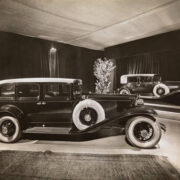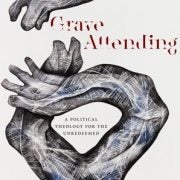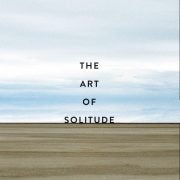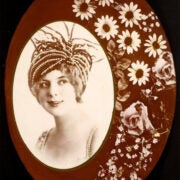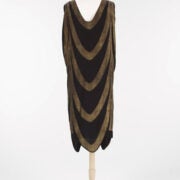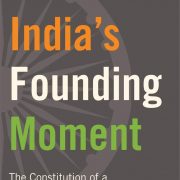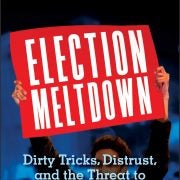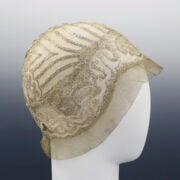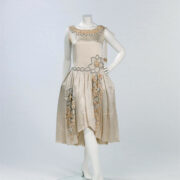Fashion from the Great Gatsby’s roaring twenties
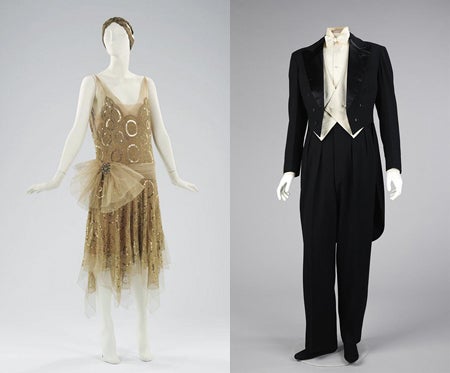
Left: Jeanne Lanvin | Ensemble, Evening; Summer 1923. Right: Jeanne Lanvin | Suit, Evening (Tuxedo); 1927. Brooklyn Museum Costume Collection at the Metropolitan Museum of Art | Image © The Metropolitan Museum of Art
“I noticed that she wore her evening dress, all her dresses, like sports clothes—there was a jauntiness about her movements as if she had first learned to walk upon a golf course on clean, crisp, mornings.”
–F. Scott Fitzgerald, The Great Gatsby
The recent movie adaptation of The Great Gatsby has turned the spotlight on the fashion and styles of the Roaring Twenties. So what made the twenties roar?
The economic boom was decisive. Soldiers came home from World War I to jobs in manufacturing plants ready to turn from war production to consumer goods; with the flourishing economy, many commodities became affordable for the first time. Another key engine for progress was the 19th Amendment to the Constitution, which granted women the right to vote. It was signed into law in 1920, heralding unprecedented liberation. The twenties were also a pivotal time for mass communication: radio, cinema, and the automobile sped up the distribution of information—and trends.
- Byron Company | Auburn Sales Co., Cord Front Drive Car Exhibit, two cars; 1929 | Museum of the City of New York; mcny.org
- Unidentified | Woman in flapper dress | ca. 1925 | George Eastman House; eastmanhouse.org
Inevitably, fashion began to reflect the changes in society. Women moved away from restricting fashions to more comfortable clothes. Flappers, as rebellious young women were known, turned their backs on corsets, dropped their dress waistlines to the hips, and bobbed their hair. Skirts rose to just below the knee, allowing flashes of leg when dancing the Charleston, the Lindy Hop, and the Foxtrot. Popular hat styles included the Newsboy cap and Cloche hat, and high heels came into vogue. Men’s styles, although slower to change, also shifted from highly formal daily attire to more comfortable garments.
- Unknown | Dress, Evening; 1925 | Brooklyn Museum Costume Collection at the Metropolitan Museum of Art | Image © The Metropolitan Museum of Art
- André-Edouard Marty | “The Annamite Soubrette – Evening Gown by Doeuillet, trimmed with ribbon”; 1920 | Gazette du Bon Ton (Minneapolis College of Art and Design) | © 2008 Artists Rights Society (ARS), New York / AD
- Marshall Field & Company | Shoes, Evening (T-strap Shoes); ca. 1927 | Brooklyn Museum Costume Collection at the Metropolitan Museum of Art | Image © The Metropolitan Museum of Art
- Jeanne Lanvin | Hat, Evening (Cloche); ca. 1925 | Brooklyn Museum Costume Collection at the Metropolitan Museum of Art | Image © The Metropolitan Museum of Art
- Unknown (American) | wedding dress; June 1928 | Image © Indianapolis Museum of Art
The Artstor Digital Library has many resources for the study of the 1920s. Particularly rich are collections such as the Museum of the City of New York, which features tens of thousands of images documenting New York City’s changing cultural, political, and social landscape from its earliest days to the present; The Metropolitan Museum of Art: Brooklyn Museum Costumes, which documents nearly 6,000 American and European period costumes and accessories; Gazette du Bon Ton (Minneapolis College of Art and Design), images of French fashion plates that offer a unique visual record of fashion and high society in the early 20th century; and Eyes of the Nation: A Visual History of the United States (Library of Congress), an overview of American history through images of works within the Library of Congress’ special collections. To find even more images, click on “Advanced Search,” set the date parameters from 1920 to 1929, then click on the classification of your interest.
